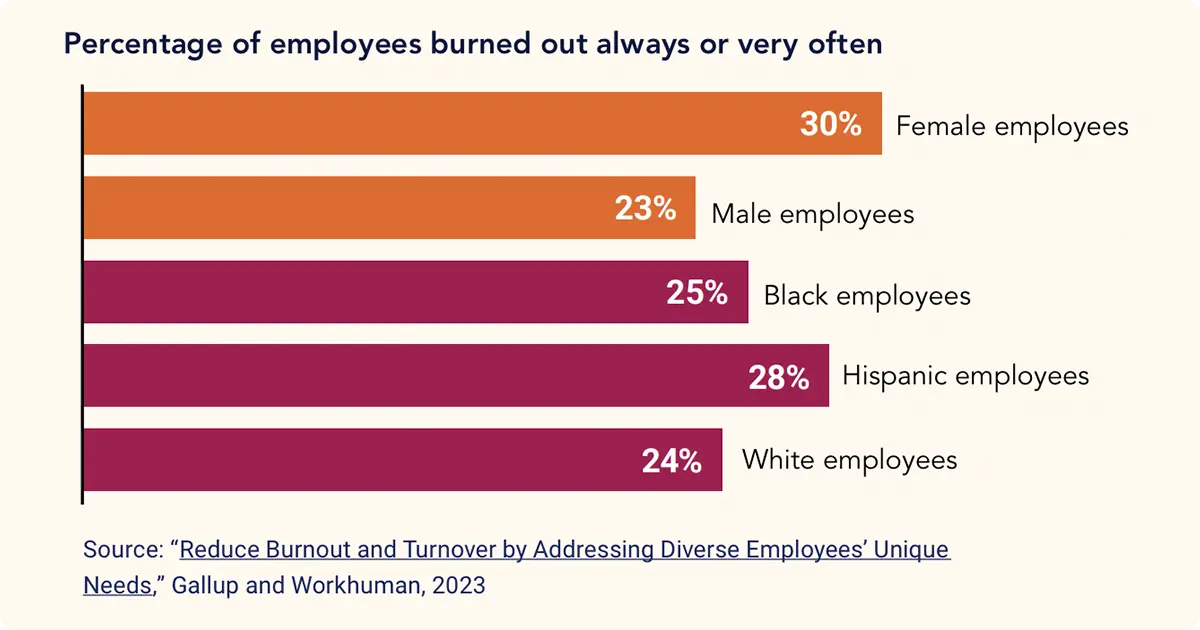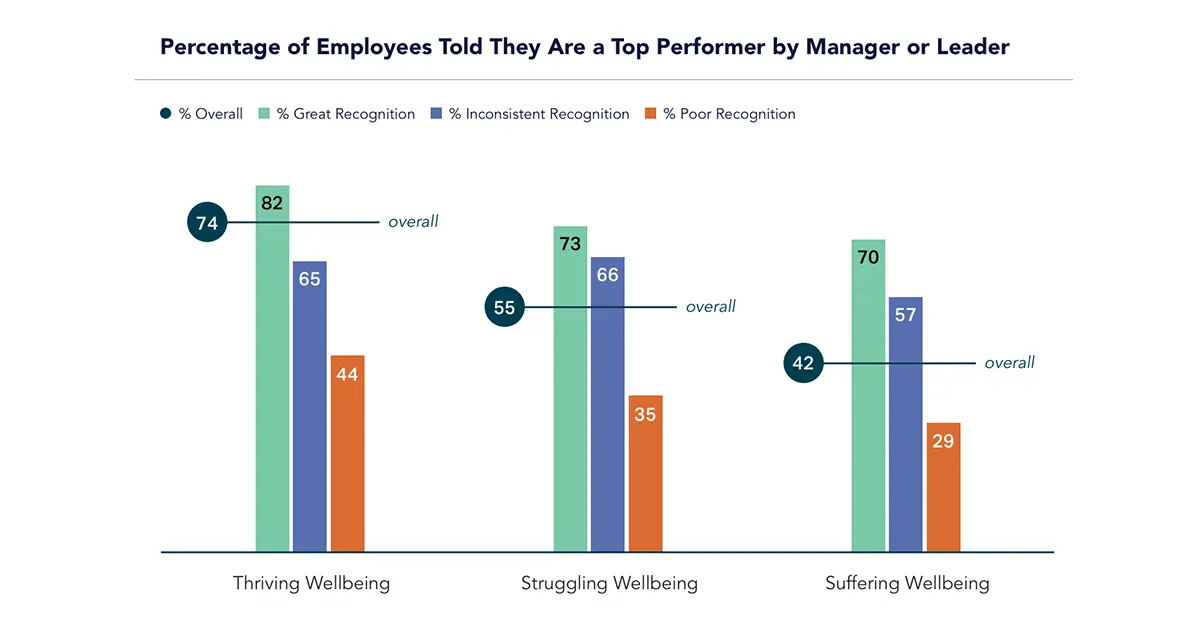How to Build Resilience in the Workplace and Debunking Common Myths

Burnout is a global phenomenon affecting workers across industries. In fact, Deloitte found that 77% of employees surveyed Opens in a new tab experienced burnout and workplace stress at their current job. This doesn’t just take a toll on mental health – it also drags down productivity.
At a recent Workhuman® Live conference, Accenture Chief Health Officer Dr. Tamarah Duperval-Brownlee (also known as Dr. Tam) and Workhuman® Sr. Director, People Analytics & Research, Dr. Meisha‑ann Martin, sat down to discuss burnout. In this conversation, one top takeaway was revealed.
A key antidote to burnout is resilience in the workplace. Building resilience is a crucial means to foster more engaged employees and build a positive work environment. Read on to see how burnout and workplace resilience are connected.
Mental health & burnout myths
In this article we'll look at three top myths and misconceptions about personal resilience, burnout, and mental health in the workplace.
Uncover three pervasive burnout myths and powerful strategies to reduce workplace stress.
Misconception #1: Burnout affects everyone equally
Burnout doesn’t look any one way; it affects every person differently. Common signs include:
- Increased absenteeism and/or sick days
- Higher sensitivity to constructive feedback
- Decreased productivity or performance
- Disengagement from work projects and/or team activities
- Complaints of insomnia, difficulty sleeping, or low energy
- Inability to concentrate
- Sudden changes in behavior (i.e., easily angered or upset)
- Having a negative, critical, or cynical attitude toward the job and colleagues/clients
- Thoughts of quitting or switching roles
- Making unhealthy lifestyle choices
The mental health phenomenon also doesn’t affect every social group the same. According to Dr. Martin, based on research at Workhuman, “In our typical samples, we see about one-third of people saying that they’re burned out at least sometimes – specific to women, closer to 80%.”
In research from Gallup and Workhuman about burnout across demographics, it was found that burnout affects different groups at different rates, and that women are experiencing burnout at the highest rate, especially women in management.
Across the U.S., three in 10 employed women report that they always or very often feel burned out at work. (The most across measured demographics.)

This is why you need to measure workplace stress by demographic – the data will reveal patterns that generic company-wide surveys won’t show. Workhuman iQ fuels this information, revealing employee resilience and burnout rates across gender, ethnicity, and more so that you can facilitate a more equitable work environment.
Misconception #2: If I don’t give 120%, 100% of the time, I’m not giving my best
Employees take their personal resilience seriously. They often feel incredible stress to perform at the highest possible level, sometimes at the cost of their mental or physical health. With that kind of pressure, the ability to manage stress feels nonexistent.
Dr. Tam explains:
You only have 100%. The fallacy that you can do a 120% is wrong….So, if you’re going to prioritize, 30% is your family and kids, this percentage is what you’re going to give for work, this is the percentage that you’re going to give for care for yourself – that is it. So, you’re going to manage work, for example, within the 25% that you have.
According to Gallup, two top reasons for burnout include an unmanageable workload and unreasonable deadlines and pressure. To combat this, consider how you can encourage a growth mindset that doesn’t come at the cost of employee health and wellbeing. Otherwise, you risk weakening resilience at work.
Having candid conversations about healthy work-life balance, role expectations, and appropriate boundaries can pay dividends by helping employees get ahead of burnout before it’s too late. Resilient employees are healthy employees!
Misconception #3: Stress is just a part of the job
Yes, occasional stress is a part of most jobs – and sometimes, it can even be a healthy motivator to get to the finish line of an important task. Building employee resilience can even help employees withstand workplace stress with better self-regulation.
However, according to Harvard Business Review, “Research has consistently shown that chronic overwork leads to a decrease in productivity, higher absenteeism and turnover, poorer health, and burnout.” So, how can you identify when healthy stress is starting to slip into chronic overwork?
Dr. Tam and Dr. Martin discussed the concept of “a job +1.” Part of the “+1” is all those extra tasks that are handed off to an employee but eventually, over time, become more like a second or third job. Even the most resilient employees have limits, and this “job+1” can add up to an unwieldy amount of day-to-day tasks and stress.
Combat workplace stress by ensuring workloads are equitable and realistic. Advocate for more hands when needed. Don’t rely on employees’ motivation and personal resilience to add to an ever-growing output; know that at some point, more people will be needed.
Using recognition to interrupt burnout & foster workplace resilience
Employee recognition is key to combating burnout and building resilience in the workplace. When done right, recognition can boost personal resilience by making employees feel more connected and appreciated. It also encourages emotional intelligence, a key factor in a healthy work environment.
A report from Gallup and Workhuman defines the five pillars of good recognition as fulfilling, authentic, personalized, equitable, and embedded in the culture. This means recognition can facilitate strong relationships, professional development, and, in turn, more resilient employees.
In research with Gallup, Workhuman found that workers who feel they get the “right” amount of recognition are 30% less likely to experience burnout than those who do not believe they are getting the right amount of recognition.
Here are our top tips for using recognition to build workplace resilience and reduce burnout:
1. Recognize in the moment. Timely recognition can reinforce and drive the repetition of the positive behaviors being celebrated. If you wait, you’re weakening the impact of your colleague’s achievement.
Through the Workhuman platform, your employees can nominate colleagues for recognition, create check-ins, and send feedback without ever leaving the apps where they work. This makes in-the-moment recognition a seamless experience for all.
2. Recognize your colleagues for what they do and who they are. Gallup and Workhuman research found that employees recognized for work and life events are 3x as likely to feel connected to company culture, 3x as likely to say their company cares about their wellbeing, and more than 30% more likely to say they plan to remain at the organization. Celebrating the whole human makes for a more resilient human.
3. Recognize holistically by highlighting “invisible” work. The skills and collaboration required to complete a project are just as important to recognize as getting to the finish line. Workhuman research has seen that a strong culture of recognition means workers receive a mix of rewards for both achievements and community built.
With Workhuman iQ, you can uncover the types of recognition given, as well as the skills, biases, trends, and themes in your unique recognition data. In doing so, you can celebrate emotional resilience just as much as a job well done.

Workhuman iQ can transform your understanding of the employee experience with AI-powered social analytics to unlock data-driven strategy. It's the kind of intel you’ve always wanted, delivered in a way that anyone can use.
Key techniques to foster resilience in the workplace
Workplace resilience is cultivated intentionally – it doesn’t just happen. Building resilience comes from embracing challenges and managing stress mindfully, not from overwork and burnout. Encourage these behaviors and techniques to help build employee resilience.
Take meaningful breaks
That’s right – taking a break helps you keep going. Meaningful breaks and mindful moments like breathwork, yoga, or walks can help build up emotional resilience and improve physical health by hitting “reset” during the day.
Taking time to recharge helps you return to work refreshed and refocused to continue tackling day-to-day tasks. Remember, rest is productive. If you want to promote innovation, promote breaks alongside it.
Cultivate compassion
Compassion is a powerful tool for emotional resilience and overall mental health. According to research cited by the Greater Good Science Center at UC Berkley, compassion can help facilitate positive relationships at work, boost collaboration, and increase feel-good emotions.
Having compassion as a leader means celebrating employees for their whole-human selves, which can reduce pressure and, in turn, lower stress, making for a more resilient workplace culture.
Self care
Resilience in the workplace depends on employees who take care of themselves. A cohort of overworked and burned-out people can’t meaningfully collaborate and overcome challenges as readily as those who prioritize mental and physical wellbeing.
Why? Because it’s all interconnected.
You can’t just “turn off” your emotions at work. Part of resilience is embracing every facet of oneself, from utilizing emotional intelligence to tackling unexpected challenges head-on.
Develop a growth mindset
A growth mindset is inherent to workplace resilience. This means framing challenges and failures as growth opportunities and building resilience in the face of such adversity. It also means not being afraid to try new things and take risks in the name of innovation.
Embrace problem-solving
Resilient employees are able to stay level-headed while solving problems and making tough decisions. It’s important, however, to manage stress in the process. While everyone has to work under difficult conditions sometimes, a continuous culture of stress only leads to a weakened workforce.
Set realistic goals
Biting off more than you can chew is a recipe for burnout and overwhelm. Workplace resilience is contingent upon realistic goals that balance pushing employees to their full potential without teetering over the edge into an excessive workload. Resilient workforces are built by teams who can embrace the dynamic process of shifting day-to-day tasks and who know how to use teamwork to meet deadlines.
Foster a culture of belonging
When you feel like you belong, it’s easier to withstand tough moments. A sense of belonging in the workplace makes employees feel psychologically safe, boosting psychological resilience. Feeling safe goes a long way, increasing overall performance and even reducing turnover. Knowing that you belong means you can stay resilient through challenging moments and manage stress with less strife.
Discover how social support drives inclusion. Read our white paper, The Case for Belonging, for key insights and actionable steps.
Conclusion
Building resilience in the workplace isn’t just about encouraging employees to withstand challenges with grace. It’s about fostering a work culture where people are celebrated for who they are and encouraged to take care of themselves while meeting personal and organizational goals.
In prioritizing employee mental health and mitigating workplace stress, you can empower workplace resilience that rewards creativity and compassion just as much as productivity and collaboration.
About the author
Maeve Ginsberg
A wellness enthusiast and the mid-day walk’s #1 fan, Maeve champions work-life balance.
Having gone from a corporate job to self employment, Maeve has lived through countless working styles. This evolution forced confrontation of her own limiting beliefs, eventually breeding a completely individualized approach to work and productivity.
As a Senior Copywriter, Maeve often writes on workplace wellbeing and strives to advocate for all workers and leaders to find small yet significant ways to make their work lives healthier and more fulfilling.
Offline, Maeve enjoys testing new cuisines and hanging upside down off walls (also known as bouldering).